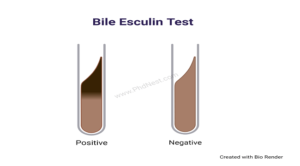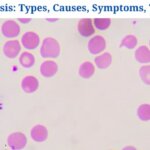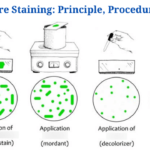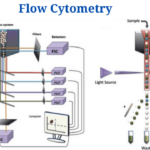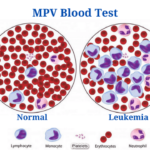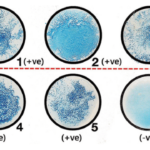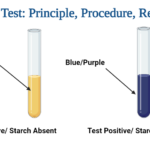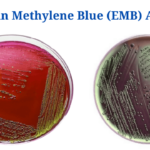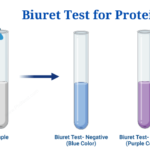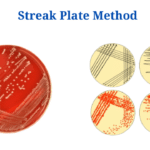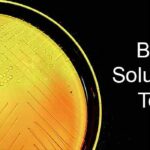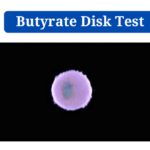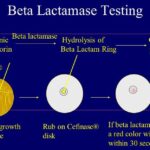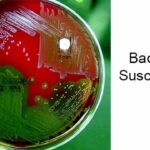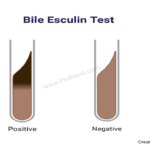What is Bile Esculin Test ?
The bile esculin test is a biochemical test that uses the capacity to hydrolyzeesculin to distinguish Enterococci and group D Streptococci from non-group D viridans group Streptococci.
- Although many species can hydrolyzeesculin, only a handful can do it in the presence of bile (4 percent bile salts or 40 percent bile.). As a result, this feature is used to identify organisms belonging to a specific group.
- The Bile-esculin test is performed on bile esculin agar, a selective differential agar that contains both bile and esculin.
- The agar contains several bile salts that prevent the growth of other Gram-positive organisms, allowing Enterococci and Group D Streptococci to be isolated selectively.
- Esculin is a luminous glycosidiccoumarin derivative (6-beta-glucoside-7-hydroxy-coumarin), and its hydrolysis can also be seen by the loss of fluorescence.
- Through the years, the bile-esculin test has been improved and made more quick. Bile-esculin discs are now widely utilised to distinguish between Group D Streptococci and non-Group D Streptococci.
Objectives of Bile Esculin Test
- To find the ability of Enterococci and Group D Streptococci to hydrolyzeesculin in the presence of bile.
- To distinguish Enterococci and Group D Streptococci members from other viridans and non-Group D Streptococci.
Bile Esculin Test Principle
- The esculin test is based on the hydrolysis of esculin in the presence of bile salt due to esculinase’s enzymatic action.
- Esculin is a glucoside made up of glucose and hydroxycoumarin connected by an ester bond in the presence of oxygen.
- The bile esculin test first selects organisms based on their capacity to grow in a medium containing 4% bile salts, then selects organisms based on their ability to hydrolyzeesculin.
- When esculin is hydrolyzed, glucose and a molecule called esculetin are produced.
- Following esculin degradation, the esculetin formed by esculin hydrolysis combines with iron ions (from ferric citrate) in the medium to form a phenolic iron complex, giving the product a dark brown or black hue.
- Esculin, on the other hand, is a fluorescent chemical, and its hydrolysis is visible as a loss of fluorescence.
- In order to hydrolyzeesculin, the microbe must be able to grow in the presence of bile in the medium. Other Gram-positive organisms are inhibited by the bile, making the medium more selective.
- The bile esculin medium contains 40% bile (equal to 4% oxgall), which inhibits most Streptococci strains except Streptococcus bovis, but not Enterococci or Listeria.
Microorganism Tested
- Gram-positive cocci that are catalase-negative and morphologically identified as presumptive S. bovis in chains.
- As part of the distinction of enterococci from other pyrrolidonyl—naphthylamide (PYR)-positive organisms, isolates of alpha- or gamma-hemolytic, Gram-positive cocci were obtained.
- Presumptive Listeria are nonspore-forming, hemolytic, Gram-positive rods that are catalase-positive and morphologically identifiable.
- Positive blood cultures containing Gram-positive cocci in chains or Gram-positive rods to diagnose enterococci and Listeria quickly (within 4 hours).
- For the identification of oxidase-positive aerobic Gramnegative rods, such as Aeromonas and yellow-pigmented non-glucose-fermenting rods, Esculin without bile is used.
Media, Reagents, and Supplies Used
Media Used
- Iron(III) citrate slants bile-esculin agar. Agar plate media with a similar formulation, such as Enterococcosel agar, are available.
- Agar containing bile, esculin, and azide, or broth containing iron(III) citrate and azide. Most Gram-negative bacteria are inhibited by azoide.
- Broth with peptose, yeast, and esculin (usually in the anaerobic atmosphere).
- Esculin agar (0.1 percent esculin in cardiac infusion basal medium) containing iron(III) citrate but no bile or azide.
The following is a list of the ingredients in Bile Esculin Agar:
[ninja_tables id=”3904″]Reagents and Supplies Used
- UV radiation with a wavelength of 360 nanometers.
- 1 % ferric [ferrous(III)] if the medium does not contain iron(III), ammonium citrate.
Procedure of Bile Esculin Test
Preparation of Media
- 64.5 grammes of dehydrated powder or lab-prepared media are mixed with 1000 millilitres deionized or distilled water in a beaker.
- The medium is then brought to a boil to completely dissolve the powder.
- The dissolved medium is then poured into tubes and sterilised in an autoclave for 15 minutes at 15 lbs pressure (121°C).
- After the autoclaving process is completed, the tubes are removed and cooled to a temperature of around 40-45°C in a tilted posture. To obtain butts of 1.5–2.0 cm depth, the posture should be maintained.
Esculin Hydrolysis
A tube test or a disc test can be used to detect esculin hydrolysis. A disc test is a quick examination.
Tube test
- With the use of a sterile inoculating needle, a well-isolated colony is extracted from an 18-24 hour culture.
- The light inoculum from the culture plate is streaked across the surface of the bile esculin agar tubes.
- For enterococcus and S. bovis identification, a 10-l calibrated loopful of a 0.5 McFarland standard suspension prepared in sterile water is used, and the tubes are inoculated with a 10-l calibrated loopful of a 0.5 McFarland standard suspension prepared in sterile water.
- To maintain appropriate aeration, the test tube caps should be left unfastened.
- After that, the tubes are incubated aerobically at 35-37°C for 24 hours (or up to 7 days for Gram-negative rods and anaerobes that develop slowly), and the colour change is noticed.
- The tubes in the esculin broth without iron (III) citrate are checked daily for decrease of fluorescence.
- 2 or 3 drops of 1.0 percent ferric ammonium citrate are added to the esculin tube if there is no fluorescence.
Disk test
- A single drop of distilled or deionized water is used to moisten the esculin disc. However, the disc should not be saturated.
- Two to three well-isolated colonies are selected from an overnight (18 to 24-hour) culture using a sterile loop.
- After about 10 minutes at room temperature, the disc is examined for the formation of a dark brown or black tint.
PhD in Psychology : Career, Admission Process, Benefits, Opportunities.
Result Interpretation of Bile Esculin Test
- The blackening of the medium indicates a positive tube test in medium containing ferric ammonium citrate.
- A lack of colour change indicates a negative tube test. Under UV light, the medium will glow (366 nm).
- A positive test for esculin broth without iron (III) citrate is shown by the broth turning black after adding the ferric [iron(III)] reagent or the medium losing its fluorescence.
- In the bile-esculin medium, a negative test result can also occur if the organism cannot grow in the presence of bile, independent of its capacity to hydrolyzeesculin.
- The development of a dark brown or black colour on the disc indicates a positive disc test.
- A colourless disc test results in a negative result.
The development of various bacteria and their bile esculin hydrolysis test are shown in the table below:
[ninja_tables id=”3906″]Uses of Bile Esculin Test
- The bile esculin test is used to isolate Enterococci and Group D Streptococci as a biochemical test.
- It can also be utilised to distinguish these organisms from Streptococci viridans and other Gram-positive bacteria.
- Enterococcia, Listeria, and Yersinia enterocolitica can all grow on bile esculin agar, which is a selective differential media for their growth.
Limitations of Bile Esculin Test
- Other viridans group streptococci, such as S. bovis, may produce a positive reaction on bile-esculin agar if a large inoculum is used or if the bile concentration is less than 40%.
- S. bovis (previously known as group D streptococci) and other viridans group streptococci cannot be distinguished using esculin tests without bile.
- Several species create H2S during metabolism, which reacts with iron to form a black complex, interfering with the results of the esculin hydrolysis test and potentially leading to a false-positive result.
- Some microorganisms with -glucosidase, such as E. coli, will only give a positive result in this test after a long period of incubation.
Bile Esculin Test Citations
- https://jcm.asm.org/content/36/4/1135
- https://clinicalgate.com/gram-positive-cocci/
- http://www.austincc.edu/microbugz/bile_esculin_test.php
- http://microsc.net/materials/4net/laboratory_syllabus/use_of_selective_and_differential_media.pdf
- https://vlab.amrita.edu/?sub=3&brch=73&sim=703&cnt=2
- https://pubchem.ncbi.nlm.nih.gov/compound/fluorescein
- https://persianlab.com/strepiococcus-enterococcus-and-other-catalase-negative-gram-positive-cocci/
- https://en.wikipedia.org/wiki/Bile_esculin_agar
- https://www.sciencedirect.com/topics/medicine-and-dentistry/streptococcus-group-d
- https://www.coursehero.com/file/p610isqs/Alternatively-esculin-is-a-fluo-rescent-compound-and-its-hydrolysis-can-be/
- https://www.bd.com/resource.aspx?IDX=8992
- https://en.wikipedia.org/wiki/Agar_plate
- https://biologicalindicators.mesalabs.com/wp-content/uploads/sites/31/2014/02/Unique-Cycles-Sterilizing-Liquid-Loads.pdf
- https://asm.org/Articles/2020/January/Microbiology-Laboratory-Tips-and-Tricks-An-Organis
Related Posts
- Anisocytosis: Definition, Types, Causes, Symptoms, Treatment
- Endospore Staining: Principle, Procedure, Reagents, Results
- Flow Cytometry: Overview, Principle, Steps, Types, Uses
- Northern Blot: Overview, Principle, Procedure and Results
- MPV Blood Test: Calculation, High and Low MPV Value, Results
- Latex Agglutination Test: Objectives, Principle, Procedure, Results
- Iodine Test: Definition, Objective, Principle, Procedure, Results
- Eosin Methylene Blue (EMB) Agar
- Biuret Test for Protein: Purpose, Objectives, Principle, Procedure, Reagents
- Streak Plate Method: Meaning, Principle, Methods, Importance, Limitations
- Bile Solubility Test: Objective, Principle, Procedure, Results, Uses
- Butyrate Disk Test: Objective, Principle, Procedure, Results, Uses, Limitations
- Beta Lactamase Test: Objective, Principle, Procedure, Results, Limitations
- Bacitracin Susceptibility Test: Objective, Principle, Procedure, Results, Uses, Limitations
- Bile Esculin Test: Objective, Principle, Procedure, Result, Uses, Limitations

